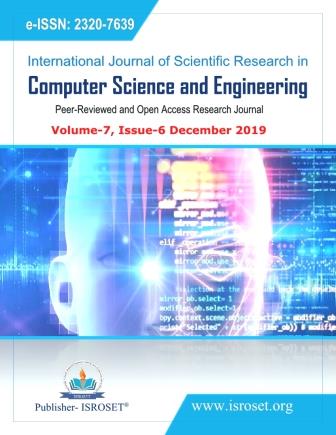Detection of Cross Language Clones of C and Java Language using Levenshtein Distance Algorithm
Keywords:
type-III, type-IV clonesAbstract
In code engineering the study on software forking presents that 10-15% of the code in large codebase are clones. gcc-8.7%, JDK-29%, Linux-22% There are state of art tools for detecting clones like CCFinderX, EqMiner, Dup, Simjava, Nicad but cannot work with IDE’s hence To solve the software maintenance efforts in development process it is important to propose efficient techniques to identify clones(especially type-III and type-IV clones) .we propose dictionary based Approach to detect cross clones of C and Java to provide proper inputs to the developers who engage in software forking or porting activities by detecting and correcting porting and copying errors that arise during porting process for IDE’s like NetBeans, Eclipse.
References
F. Alomari, I. Keivanloo, C. K. Roy, J. Rilling, “Detecting Clones across Microsoft .NET Programming Language”s, 1095-1350/91 4891 IEEE.
M. Abdelkader M. Malki, “Clone Detection Using Time Series and Dynamic Time Warping Techniques”,978-1-4673-9669-1/15, 2015 IEEE.
B. Ray, C. Wiley, M. Kim, “REPERTOIRE: A Cross-System Porting Analysis Tool for Forked Software Project”s, SIGSOFT’12/FSE-20,November,11–16,2012, Cary, North Carolina, USA. Copyright 2012 ACM 978-1-4503-1614-9/12.
S. Abid, S. Javed, Momna Naseem, Suleman Shahid, H.Abdul Basit,Yoshiki Higo,”CodeEase: Harnessing Method Clone Structures for Reuse”, 978-1-5090-6595- 0/17, 2017 IEEE .
B.B.chua, “Detecting sustainable programming languages through forking open source project for survivability”y, 978-1-5090-1944-1/15, 2015 IEEE.
F.-Hsiang Su, J.Bell, G.Kaiser, S. Sethumadhavan, “Identifying Functionally Similar Code in Complex Codebases”, ICPC 2016, Austin, Texas, 978-1-5090-1428-6/2016 IEEE
F. Deissenboeck, L. Heinemann, B. Hummel, and S. Wagner, “Chal-lenges of the Dynamic Detection of Functionally Similar Code Fragments,” ser. CSMR ’12.
Y.Yuan and Y. Guo, “Boreas: An Accurate and Scalable Token-Based Approac to Code Clone Detection” ,2013 International Conference on Software Engineering.
B. Priyambadha, S. Rochimah, “Case Study on Semantic Clone Detection Based On Code Behavior”, 978-1-4799-7996-7, 2014 IEEE.
F. Mihai Lazar, O. Banias, “Clone detection algorithm based on the Abstract Syntax Tree approach”, 9th IEEE International Symposium on Applied Computational Intelligence and Informatics • May 15-17, 2014 • Timişoara, Romania.
C. Ragkhitwetsagul, “Measuring Code Similarity in Large-scaled Code Corpora”, 978-1-5090-3806-0/2016 IEEE.
V. Saini, H. Sajnani, J. Kim, and C. Lopes, “SourcererCC andSourcererCC-I: Tools to Detect Clones in Batch mode and During Software Development,” ICSE’16 Companion, May 14-22, 2016, Austin, TX,USA c 2016 ACM. ISBN 978-1-4503-4205-6/16/05.
C. K. Roy, “Detection and Analysis of Near-Miss Software Clones”, 978-1- 4244-4828 2009 IEEE.
www.mtsystems.com
M.Steinbeck, “an Arc-Based Approach for Visualization of Code Smell”s, 978-1-5090-5501-2, 2017 IEEE
Y. Hu, Y.Zhang, J. Li, D. Gu, “Cross-Architecture Binary Semantics Understanding via Similar Code Comparison”, 2016 IEEE 23rd International Conference on Software Analysis, Evolution, and Reengineering.
D. Mazinanian, N. Tsantalis, R. Stein, Z. Valenta, “JDeodorant: Clone Refactoring”, 2016 IEEE/ACM 38th IEEE International Conference on Software Engineering Companion
T. Ishio, Y.e, Kaoru, “source file search file for clone and own”, 2017 IEEE, 14th International Conference on Software Repository
K. Raheja,, R. Tekchandani, “An Efficient Code Clone Detection Model on Java Byte Code Using Hybrid Approach”
M. Stephan,James R. Cordy, “Model-Driven Evaluation of Software Architecture Quality Using Model Clone Detection”, 978-1-5090-4127-5/ 2016 IEEE
Downloads
Published
How to Cite
Issue
Section
License

This work is licensed under a Creative Commons Attribution 4.0 International License.
Authors contributing to this journal agree to publish their articles under the Creative Commons Attribution 4.0 International License, allowing third parties to share their work (copy, distribute, transmit) and to adapt it, under the condition that the authors are given credit and that in the event of reuse or distribution, the terms of this license are made clear.







